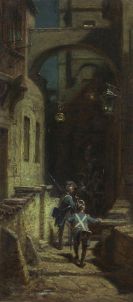
Gustave Courbet
1819 Ornans
1877 La-Tour-de-Peilz
Gustave Courbet was born on 10th July 1819 to a wealthy farming family in Ornans. His precise powers of observation, his love of detail, and the expressive colours and plasticity of his figures, broke every academic rule and paved the way for Realism. The artist attended his first drawing classes under the tutelage of Charles Antoine Flageolet, when he was still at school.
In 1839, Gustave Courbet travelled to Paris, and studied briefly under Carl von Steuben and Alexander Jean-Baptist Hessle. He continued to teach himself, by copying old masters in the Louver or undertaking intensive studies of nature. Despite successfully exhibiting at the Paris Salon, from 1844, Corbett’s works were continually rejected. In 1849, after the first jury-free Salon was held, the artist began to show his work regularly at the exhibitions there. His friends and admirers were enthusiastic about his socially critical work, which, in contrast employed an entirely new, realistic form of representation, which, however, largely met with public derision and rejection.
In 1855, Gustave Courbet was excluded from the World Exhibition and so he organised his own exhibition in a pavilion. Although Courbet was only moderately successful in France, his work had a strong influence on the German realism of the 1850s. In Frankfurt and Munich, Courbet was highly praised for his brilliant technique and forms of expression. Courbet’s painting "Burial at Ornans" (1849) and "The Artist’s Studio" (1855) (both works are kept in the Musée National du Louvre, Paris), paved the way for a new, realistic form of representation in art.
The more opposition Courbet faced from the French cultural world, the more politically opposed to the French Second Empire his work became. Courbet’s participation in the destruction of the Vendom Column had serious consequences.
After serving a prison sentence, he was ordered to pay the costs of Column’s reconstruction, and so he fled to Switzerland. Poverty- stricken and demoralised, Courbet attempted to make a new start in La-Tour-de-Peilz by Lake Geneva. He executed a number of still-lifes, nudes and landscape images there.
Gustave Courbet died on 31st December 1877.

Would you like to sell a work by Gustave Courbet?
Infos for sellerART MARKET:

Die Scharwache
Oil on paper, laminated on panel, 1875
Post-Auction Sale 70.000
More offers >






